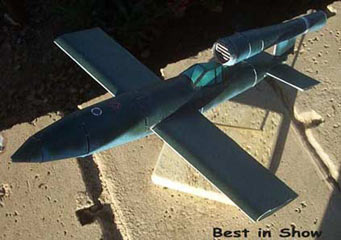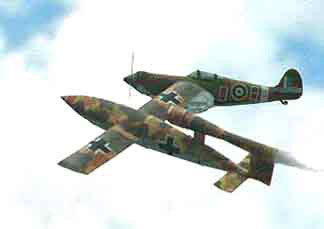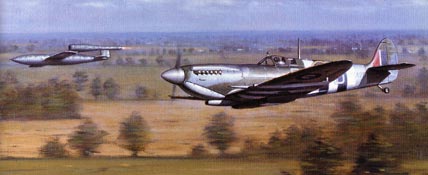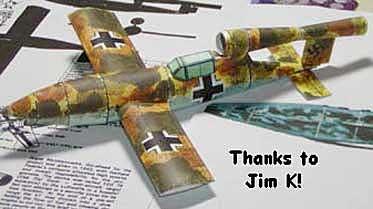
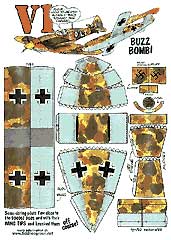


The WWII V-1 Doodle Bug Flying Bomb
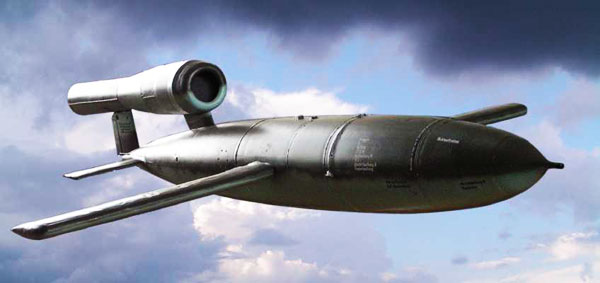
| The German V1 flying bomb, or 'buzz' bomb, known originally as the Fieseler Fi 103, was the first of the Vergeltungswaffen "weapons of vengeance," named in response to Allied air assaults on Germany during World War II. It emerged from proposals made in 1939 by the Argus Motorenwerke.
Although prone to mechanical failure and vulnerable to fighters, barrage balloons, and anti-aircraft fire, the V-1 nevertheless caused great destruction to targets in England and Belgium. Troops and civilians subjected to these attacks nicknamed them "doodlebugs" or "buzz bombs". The flying bomb concept can be seen today in the modern cruise missile. |
|
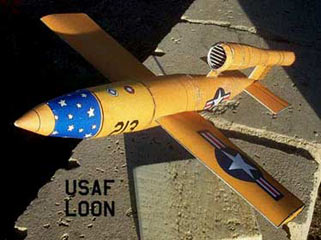 |
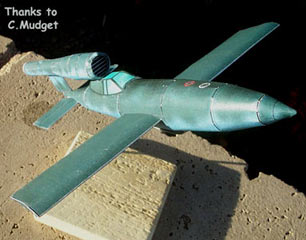 |
Even though they were designed for destruction,
they're pretty nifty little thingies...
Z
JP-2 Loon. I built this in the LARGE size some years ago and use it occasionally in my IPMC display. A good model that has excellent fit and would be good for a beginner in the LARGE size. The Loon in "regular" size is another matter entirely. The regular .pdf is set up to print across the paper grain, which causes cracking and breaking when you try to roll the body tube parts. I used an old approach, dampening a paper towel (actually got it quite wet), and rubbing it on the back of the body sections. If you spray the printout with Krylon or other clear spray on the front, the ink stays waterproof enough to allow you to handle and roll the sections, perfectly. Aleene's Tacky Glue adheres easily to the wet paper. A beginner or first-time modeler wouldn't know this trick, so in the regular size it's not a good choice. The LARGE size, however, is a perfect choice for the first-time modeler. The model fit perfectly in all respects and makes a great display item. - Alan Wheeler
I was watching Monster Garage this week. They had another
episode where they travel the country and show of other
peoples crazy machines they built.
There's a group of artists in the New York area that build
some outrageous stuff in the name of art. They welded a
pulse jet onto a stripped out motorcycle frame. That whole
jet motor was glowing white hot. I wouldn't want to be the
guy riding that thing. All he had between him and the engine
was a little heat shield so he wouldn't roast his backside.
They got it up to 36 mph on an abandon airstrip. It was
like something out of Mad Max. TW
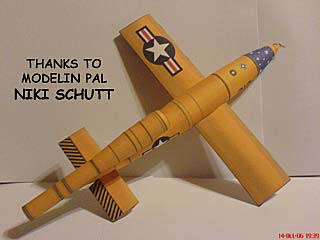
V-1 Flying Bomb
Technical Details FZG 76
Known alternatively as the FZG 76 (Flakzielgerat: anti-aircraft aiming device 76) or Vergeltungswaffe Eins (Reprisal Weapon 1), or more simply as the VI, the Fi 103 flying bomb had an airframe designed by Dipl-Ing Robert Liisser of Fieseler, and a Siemens guidance system. It could be launched from a 152ft inclined ramp by a Walter steam driven catapult, or air-dropped from a carrier aircraft (usually an He Ill).
The weapons were launched against Britain (from 13 June 1944) and targets in continental Europe. More than 30,000 were manufactured by Henschel, Mittelwerke and Volkswagen factories. An Askania gyroscope fed signals to the elevators and rudder to control attitude and direction, and the terminal dive was initiated when a pre-set distance had been flown.
Operational air launches were mostly made from He III Hs of KG 3 (later KG 63); but, whatever the launch method, about a quarter of the weapons failed in use and only about a quarter of the remainder got through Allied defenses. Even more of a desperation weapon was the Reicheflberg piloted series, of which there were four versions: the single seat and two-seat unpowered Fi 103R-I and fl-Il, the single seat powered R-lll trainer, and the proposed operational RIV. About 173 were so converted, but none was used in combat.

Hey! They got one! They got one!"
At BBC Broadcasting House in London's West End, an American Army
officer suddenly began shouting and pointing out the window.
Sergeant Dudley arrived at the window just in time to see an aircraft rushing by, its tail brightly aflame. It looked as though the local antiaircraft gunners had hit a German bomber and set it on fire. But it was not a bomber. It was a new German weapon, quite literally a "flying bomb."
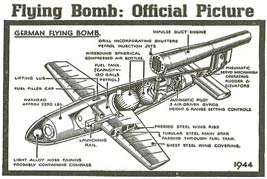 |
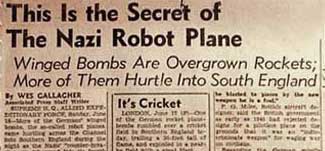 Early reports were not quite 'on target' so to speak. Note the tapered wings (left) and 'overgrown rockets' (right) |
The air raid sirens had already sounded-" deep-throated, three toned jobs that sounded as though they really meant it," was one American's description of them. When the flying bombs reached Greater London's southern boundary, the guns of the London Defense Region opened up. Anyone who missed the sirens was jolted awake by the roaring bark of the guns, which rattled windows and frightened children. Anyone who opened his blackout curtains could watch the searchlights trying to pinpoint the intruders-odd little airplanes with flaming tails-through a steady drizzle.
What observers caught sight of was a very odd aircraft, a pilotless, jet-propelled aerial torpedo that would bear many names. Officially, it was simply FZG-76-Flakzielgerat (anti-aircraft target device)-76. The anti-aircraft designation was a ruse to throw Allied spies off the track. In Britain, it was known as the "doodlebug" "buzz bomb" and "farting fury," along with a number of other comic names.
The Fieseler company that designed it designated it the Fi-103. The Nazi Propaganda Ministry called the pilotless aircraft Vergeltungswaffe (retaliation weapon) 1, or V-1. But the name almost universally favored by Britons and Americans alike was "buzz bomb."
A V-1 flying bomb resembled a small aircraft with a stovepipe mounted over its tail and no cockpit. Its overall length was just over 25 feet, with a wingspan of 17 V2 feet. Standard 80-octane gasoline kept its jet engine running, which was housed in the stovepipe assembly; this was the same fuel used by trucks. The flying bomb was easy and cheap ($500) to build and carried a 1,870-pound warhead. But while the flying bomb may have been cheap and simple, it was not very accurate-it could not hit small targets, or even moderate-sized villages. It was accurate enough to hit a target the size of Greater London, however, and that was all that was expected-a way to hit back at the Allies without risking the depleted reserves of the Luftwaffe's bomber fleet.
During the early months of 1943, extensive tests were carried out involving the FZG-76. Only nine months had passed between the beginning of work on the project in March 1942 and the first successful launch, which took place on Christmas Eve, although the flying bomb still had its share of teething problems.
One question involved the proper type of launching site for the flying bombs. Some favored large concrete emplacements; others proposed small, portable sites. As head of the Luftwaffe, Reichsmarschall Hermann Goring compromised, ordering four concrete bunkers and 96 smaller sites begun immediately.
Next, men had to be trained to handle and fire the flying bomb. A new Luftwaffe unit was formed in August 1943, called Flakregiment 155 ('N). The anti-aircraft designation was, once again, aimed at deceiving Allied intelligence.
The new unit was placed under the command of Luftwaffe Colonel Max Wachtel, who had been in charge of all the experimental flying bomb launches. Wachtel was instructed to get his men ready for firing the bomb under actual combat conditions, and he took his orders to heart; his Flakregiment began exercises within days of the unit's creation. From the western side of Peenemuende, on Usedom Island in the Baltic Sea, the launching crews began readying the small, jet-propelled planes and firing them downrange over the Baltic.
Under Wachtel, Flakregiment 155 ('N) continued its training through the winter of 1943 and into 1944. By June 1944, Wachtel and his unit were in France, ready to begin operations. But few others connected with the flying bomb project were as efficient as Wachtel.
One of the main problems was with the production
of the flying bombs themselves. Because of the many defects that
plagued the bomb, it did not go into production until March 1944.
Engineers at the Volkswagen plant at Fallersleben, near Hamburg,
did their best to work out the problems, but the pilotless planes
kept crashing immediately after launching. Full production did
not begin until April 1944, when 1,000 flying bombs rolled off
the Volkswagen assembly line.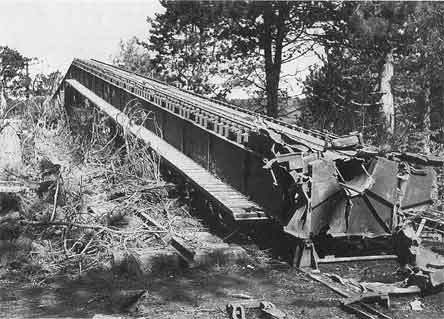
Wachtel had been ordered to begin launching the pilotless bombs against England by June, but his unit had no equipment, no launching rails and no supplies. It had been decided that lightweight launching ramps, called modified sites, would be used in place of larger ramps that had proved too vulnerable to Allied bombing attacks.
The supplies and equipment that Wachtel needed to begin operations did not arrive until June 12, 1944, only a few hours before he was to begin launching V-is against southern England. Only 10 ramps were ready for launching; 55 were supposed to have been prepared, but not enough spare parts and equipment had been sent for all of them. By 3:30 am, on June 13, the 10 firing ramps were ready. The Luftwaffe high command decided to go ahead despite the fact that so few ramps were operational.
Months of practice made the pre-launch procedure a set routine for the crews. First, the flying bomb's fuel tank was checked, to make certain that it had been topped off. Following this, the wooden wings were attached-these had been folded over the fuselage to make storing and moving the aircraft easier. After assembly, the plane was aligned precisely with its firing ramp-which was pointed directly at London-and its gyrocompass was set at zero to ensure it flew the straight course on which it had been aimed.
The flying bomb, now ready for launching, was moved onto its firing ramp. After it was loaded onto its catapult, a lug on the underside of the fuselage was attached to the catapult's firing piston. When the piston was released, it accelerated the V-1 off the launch rails in the same way that a jet plane is catapulted off the flight deck of an aircraft carrier.With the stubby-winged flying bomb poised for takeoff, the launching crew took cover inside the "control bunker," a heavily armored trailer that housed the catapult's firing controls, or lumped into a nearby slit trench. The firing officer gave an order, a technician pulled a lever, and the flying bomb's pulse-jet engine came to life with a throbbing, ear-numbing roar.
This simple jet engine was the flying bomb's most unique feature. Housed outside the fuselage, above the tail, the jet is usually described as looking like either a stovepipe or a giant blow torch. At the front end of the engine housing was a set of intake flaps that resembled a Venetian blind. These flaps opened at the beginning of the engine's cycle, allowing air to be drawn into the combustion chamber, where it was mixed with 80-octane fuel.
In the second stage of the combustion cycle, the flaps closed and the fuel-oxygen mixture was ignited. With a tremendous flash, a burst of hot exhaust shot out from the rear of the engine to provide forward thrust Immediately following the exhaust stage, the intake flaps opened again, allowing air into the combustion chamber and repeating the cycle.
This simple jet engine could complete up to 500 combustion cycles every minute, giving the flying bomb a maximum speed of about 400 mph. The engine's pulsing combustion process also gave the flying bomb its distinctive duv-duv-duv sound in flight, a sound that Londoners would soon come to recognize.
After listening for a moment to ensure that the engine was firing properly, the firing officer gave the order to launch. A second lever was pulled, releasing the catapult's piston. The flying bomb lurched forward, shot along the length of steel rail, and lumped uncertainly into the night sky. During the next half-hour, between ab out 3:30 and 4 a.m., nine more of the bombs bolted from their catapults. The launching crews watched as the small aircraft left their ramps, brilliant flashes of fire trailing from their exhausts.
Four of the shots failed, the flying bombs crashing just after takeoff, with explosions loud enough to hurt the eardrums of the catapult crews. Two of the successfully launched flying bombs crashed into the English Channel. The other four reached England; two landed in Kent, one in Surry, and one crashed in London, the intended target of all of them. The London bomb came down in Bethnal Green, East London, about three miles away from its Tower Bridge target point. The explosion killed three people and knocked out a railway bridge.
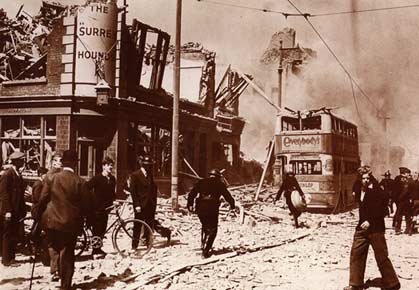 Although only four flying bombs reached England
during this first launch, hundreds more would be launched during
the next several weeks. An inexpensive, and not very accurate,
mechanism sent the flying bomb diving into its target upon arrival.
Each bomb had a small, propeller like anemometer device on its
nose that was connected to the bomb's autopilot.
Although only four flying bombs reached England
during this first launch, hundreds more would be launched during
the next several weeks. An inexpensive, and not very accurate,
mechanism sent the flying bomb diving into its target upon arrival.
Each bomb had a small, propeller like anemometer device on its
nose that was connected to the bomb's autopilot.
As the flying bomb flew through the air, its forward motion turned the propeller like a pinwheel in the wind. After a preset number of revolutions, the propeller tripped the diving controls, pointing the bomb earthward at a steep angle. The mechanism was set by the catapult crew before launching; the setting of how many revolutions were needed to trip the diving controls was based upon calculations involving the flying bomb's speed and the distance to target.
Any number of factors could undo this inherently imprecise system. Headwinds or tailwinds could alter the machine's ground speed, mining carefully worked-out calculations that were usually a lot more accurate than the mechanism itself. The autopilot might go haywire and send the bomb plunging into the Channel. Or it might not work at all, causing the bomb to over fly London and keep going until it ran out of fuel. When the windmill device tilted the bomb toward the earth, all the fuel ran to one end of the tank-the end away from the fuel pump. The pump began drawing air, and the engine, cut off from its fuel supply, stopped running.
People in London and southern England very quickly learned to use this "cutting out" of the engine to their advantage. Between the time the pulsing duv-duv-duv ended and the bomb hit the ground, an average of between five and 15 seconds would pass-enough time for people to dive under a table or some sort of cover. This characteristic undoubtedly saved many lives.
In spite of the machine's defects, Wachtel's Flakregiment 155 (W) kept launching the bombs at a steady rate. On Saturday, June 18, 1944, his unit launched its 500th flying bomb. One of them landed on Hungerford Bridge, the railway bridge across the Thames River to Charing Cross Station in London.
The explosion blew a gaping hole in the middle of the bridge, forcing one of London's major rail terminals to shut down. Later in the day, an American intelligence officer saw the damage done to the bridge-it had been blown almost in half by the explosion. He also noticed that several large buildings on the Thames embankment had all the windows facing the river blown out.
Each flying bomb had an efficient system of sensitive fuses and pressure switches that detonated the warhead on first contact, before the machine could bury its nose (and warhead) in the earth. When the 1,900 pounds of high explosives went off on the surface of a roadway, the blast cut down everything within reach. Solid walls crumbled-often, even individual bricks in a wall would be reduced to pebble-sized bits. Windows a quarter of a mile away cracked from the force of the explosion.
A central London fire station got a firsthand look at the effects from the blast of a flying bomb. The firemen had opened the station's big front doors, trying to enjoy a sunny but not very warm June day, when a buzz bomb landed less than a block away. The blast waves first slammed the heavy wooden doors shut; then, a second later, the vacuum created by the explosion wrenched them open again. When the bomb's warhead detonated, shock waves flew out in concentric circles, like gigantic ripples. As the blast waves pulsed outward, they created a vacuum behind them. One London fireman called it a "double whammy" effect-the vacuum was capable of creating as much damage as the blast itself.
In an effort to stop the flying bomb attacks, anti-aircraft defenses and more than 1,000 barrage balloons were sent to Kent, southeast of London. Bombs launched from the Pas de Calais would have to fly over this "gun belt" on their way to London. Also, eight fighter squadrons, equipped with Hawker Typhoons, Supermarine Spitfire IX's and XIV's, and Hawker Tempest Vs, flew standing patrols.
All armor and excess weight were removed. The leading edges of wings and stabilizers were polished to a high gloss. |
Because the buzz
bombs traveled at more than 400 miles per hour, the piston-engine
fighters needed all the speed they could muster. Pilots
of the modified Spitfires and Tempests could close with
the flying bombs more easily. Some could even fly right
alongside the bombs, close enough to read the German writing
on the fuselages. |
But this maneuver was not without its risks. The flying bomb was made of rolled sheet steel, while the RAF fighters had a skin of light aluminum alloy. Many a Spitfire and Tempest hobbled back to base with one of its highly polished wings bent and twisted out of shape from the "wing wrestling."
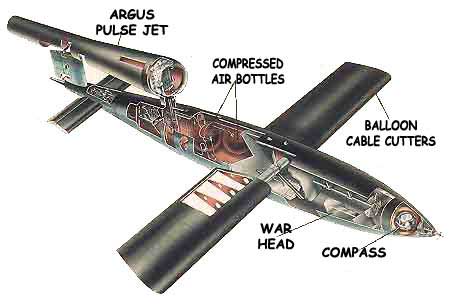 Barrage balloons were deployed against the missiles, but the leading edges of the V-1's wings were equipped with balloon cable cutters and fewer than 300 V-1s are known to have been destroyed by hitting cable. |
Bringing down a buzz bomb with gunfire also presented problems for Allied pilots. The most frequent method of attack was the deflection shot, approaching from the side and opening fire when the bomb crossed the pilot's line of sight. "It's like firing at a large flame with wings sprouting out of it," the pilot of a Tempest V said. "Your cannon scores hits, and suddenly there is a big red flash."
The top "doodlebug ace" was Squadron Leader Joseph Berry, who flew Tempest Vs with the Fighter Interception Unit, and then No. 501 Squadron. Berry's final score was 591/2 V-1s, including a one-night record of seven on July 23.
During a low-level chase four days later, he closed to 100 feet before downing the doodlebug, and his and his plane was damaged in the ensuing explosion. To his chagrin, he had to share the credit with a de Havilland Mosquito that had fired at the V-1 from 1,000 yards and, in the opinion of his unit, had "missed hopelessly."
Another noted V-1 specialist was Flying Officer R.F. Burgwal, a Dutch pilot who flew Rolls-Royce Grifon-engined Spitfire XIV's with No. 322 Squadron, a Dutch unit based in southeast England. Burgwal was credited with 21 V-1s, while a squadron mate and fellow Hollander, Flight Lt. J.L. Plesman, accounted for 12.
Number 616 Squadron could combat the pilotless planes on an equal footing. In July 1944, the unit received seven Gloster Meteors, the RAF's first jet fighter. The Meteor had a maximum speed in excess of 400 miles per hour, and could easily overtake the missiles. But the Meteor suffered from constant gun trouble-its 20mm cannons had a habit of jamming.
In spite of the balky cannons, however, the Meteors accounted for 13 flying bombs. When the guns failed, pilots could always rely upon the tipping techniques.
Meteor pilot T.D. Dean had a problem with his Meteor's cannons on August 4; he attacked a flying bomb, but his guns jammed. Undeterred, Dean maneuvered his aircraft alongside the bomb, slid a wingtip under the missile's, and executed a sharp bank, using the tipping maneuver. The V-1's gyro mechanism was thrown out of balance, and the flying bomb crashed. This was the first combat victory for an Allied jet fighter.
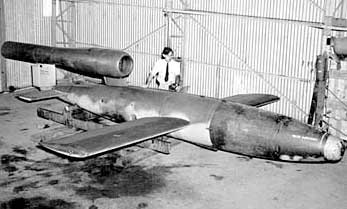 When
a flying bomb was disabled by gunfire, it behaved in the same
way as any conventional airplane-it went out of control sometimes
trailing smoke, and smashed into the earth. But the V-1s presented
some problems that fighter pilots had not encountered before.
One of the main problems was with the sheet steel skin-it deflected
.303-caliber machine-gun bullets like armor plate.
When
a flying bomb was disabled by gunfire, it behaved in the same
way as any conventional airplane-it went out of control sometimes
trailing smoke, and smashed into the earth. But the V-1s presented
some problems that fighter pilots had not encountered before.
One of the main problems was with the sheet steel skin-it deflected
.303-caliber machine-gun bullets like armor plate.
Cannon fire was most effective against the V-I; a shell from a 20mm cannon would blow a hole right through the steel outer covering. But a 20mm cannon had a much shorter range than a .303 caliber machine gun, forcing the attacking pilot to move in at close range before pressing the firing button. And if a cannon shell should hit the flying bomb's 2,000-pound warhead, the result could be disastrous for the attacker. When a buzz bomb exploded in midair, great chunks of metal sprayed in all directions. The result could be the same as having a huge anti-aircraft shell explode nearby.
Jagged shrapnel holes and blasted-away control surfaces were the reward of a careless or overeager pilot who attacked a flying bomb. At least five aircraft were destroyed by midair flying bomb explosions. One such aircraft, a Spitfire, was flown by a Free French pilot, Jean-Marie Maridor, who attacked a flying bomb at pointblank range near the south coast. The bomb's ton of Trialen exploded, blasting the Spitfire apart and killing Maridor instantly.
The flying bomb offensive against London and southern England continued throughout the summer of 1944. In late summer, the launch sites on the Normandy coast were captured by the Allied armies as they moved inland from the D-Day beaches. By the first week of September, the flying bomb attacks had all but ended. More than 2,000 of them had hit London, with many others coming down on the surrounding suburbs.
The Heinkels approached England at low altitudes to avoid radar detection. The pilot climbed to about 20,000 feet when the bomber neared the flying bomb's launching point, and he instructed the crew to start the bomb's engine and gyroscope. When everything was ready and the bomber had reached its required altitude, the V-I was released. The pilotless plane dropped for several hundred feet before it leveled out and headed toward its target. Some never pulled out, and crashed into the North Sea. But most leveled off and continued along their preset course toward the eastern coastline of England.
Only one or two of those air-launched bombs hit London every day; some shots were aimed at the port of Southampton. Apart from putting an added strain on Britain's defenses, as well as on already taut British nerves, this new attack had little effect. The last flying bomb was launched at London on March 29, 1945, only six weeks before Germany surrendered.
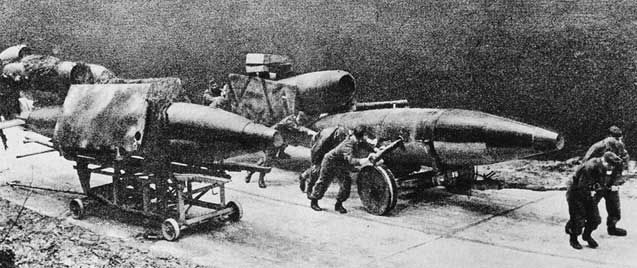 Flying straight and level-as was usually the case
when it crossed the coast-V-1 was a small, fast-moving target
for the AA guns and the fighters of the RAF. Once contact was
made by the latter, there was a choice between tipping the missile
over, or blowing it up with gunfire. Both were effective-but there
was no possible way of stopping the deadly, invisible plunge of
the V-2 rockets.
Flying straight and level-as was usually the case
when it crossed the coast-V-1 was a small, fast-moving target
for the AA guns and the fighters of the RAF. Once contact was
made by the latter, there was a choice between tipping the missile
over, or blowing it up with gunfire. Both were effective-but there
was no possible way of stopping the deadly, invisible plunge of
the V-2 rockets.
When the operational height of the V-1was found to be between 2000 and 3,000 feet, the gunners were in a difficult position: the height was too low for the heavy guns and too high for the light guns. The missiles speeds were high: from 340 mph crossing the coast to over 400 mph as they approached London.
Yet there were several aircraft that could catch it and pass it, particularly if they had some height so they could pick up speed quickly in a dive. The Spitfire XIV, Mustang Ill, Tempest V, and the Mosquito night-fighter were all fast enough-but they could not chase a V-1 too far over England before running into the areas allocated to the gunners.
No other target but London
The first real test of the existing defenses came on June 15, when Heinemann again ordered Colonel Wachtel to re-commence the attack. The catapults at 55 sites flew off 244 missiles against London within 24 hours. Of these, 144 crossed the coast of southeast England and 73 fell in the Greater London area, two-thirds of them exploding south of the Thames. Some 100 missiles failed to cross the Channel: 45 of them crashed soon after launching, wrecking nine sites; and in a French village where one crashed ten civilians were killed.
Heinemann was at Wachtel's HO bunker when the catapulting began, and stayed to listen to the spotter aircraft pilot's radio report that the glow in the target area was brighter than he had ever seen after conventional air attacks by the IX Air Corps'. The German High Command announced the attack over the radio, saying that southern England and the London area were bombarded with very high-explosive missiles of novel design during last night and this morning'. On Dr Goebbels' order the word revenge' was not used.
On June 17 the British Chiefs-of-Staff and Tedder, Hill, and Pile attended a meeting with Churchill to discuss the new defense requirements: these necessarily varied from the earlier plan, when only a few ski sites were regarded as points of enemy activity. Hill and Pile were directed to counter the attack with reinforcement of the defenses and effective deployment of the guns, aircraft, and balloons, and to General Eisenhower was sent a request for all possible measures to neutralize the supply and launching sites subject to no interference with the essential requirements of the Battle of France'.
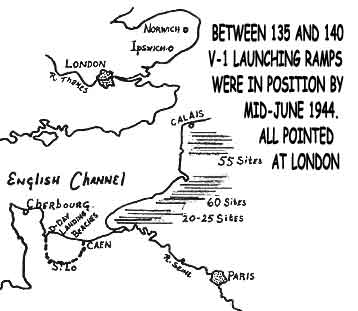
Also on June 17 Hitler flew to northern France to congratulate Heinemann and Wachtel. He forbade the regiment to aim the cherry stone', as he called the missile, at any other target but London and readily agreed to order an immediate increase in the production of the weapon. The following day a flying bomb destroyed the Guards Chapel of Wellington Barracks, a few hundred yards from Buckingham Palace. It was hit during a morning service and 121 men, women, and children were killed and 68 injured. Also on this day the 500th V1left its launching ramp.
Eisenhower readily ordered that the V-weapon bases (code-named Crossbow') should be second only in priority to 'the urgent requirements of battle'. However, the heavy air offensive against the German oil industry did not slacken to any degree because of V-site attacks which were, in most cases, quite useless, since the old supply sites were again the target.
Fortunately, Nucourt and Saint-Leu-d'Esserent were identified as V-1 store depots and heavily attacked by the US 8th Air Force during the last week in June. In the first week of July the RAF made two attacks on the heavily defended mushroom caves of Saint-LeudEsserent. In the first attack 617 Squadron dropped the 12,000-pound Tailboy' bombs: but the limestone roof of the caves held.
Much to Hitler's chagrin, Eisenhower did not order an invasion of the Dieppe area in order to chase through the Pas-de-Calais after V-1 bases-even if it were possible to mount such an invasion at short notice. The Germans did, however, benefit greatly from the deployment of Allied bombers from other activities more closely connected to the battle being fought on the ground. The Fuhrer again underestimated the British determination to put up with hardship and refusal to be coerced into making a rash move. Hitler was jubilant that England was under fire again and reported to be suffering more than it did during the Blitz. He described how the V-1 attacks were tying down hundreds of enemy aircraft . . . and bringing vital relief to the Fatherland and to the battlefields in the West'. He also seemed to be impressed by the economy of the V-1: It needs no fuel for a return flight" he boasted.
By June 29, 2,000 flying bombs had been launched against England.
Meanwhile the defenders south of London changed their formation when they found that both the guns and the fighters were restricted. The solution was to place the guns in a belt along the coast from Newhaven to St Margaret's Bay. They would have an unrestricted field of fire and their shells could explode harmlessly Out to sea instead of over towns and villages. New proximity-fuse shells would help to overcome the deficiency of the heavy guns when firing at the low-flying missiles, and radar experts decided that their equipment would work better on the coast than inland.
This positioning too gave the fighters a better chance to catch their quarry on the run from the coast to the North Downs where the balloons hung their wire tentacles, floating in thick bunches between Limpsfield and Cobham. Some 370 flying bombs- out of an estimated 1,000 launched-had reached London up to June 23. But by June 28 nearly 800 guns of all calibre were in readiness and 1,000 balloons were elevated.
The fighter pilots found that it was too dangerous to shoot down a V-i from too close behind and that the safe distance was not less than 200 yards. The best method was to allow the missile to fly past on one side, then fire a deflection shot once it was far enough away. Some pilots, particularly if out of ammunition or with jammed guns, placed a wing tip under the wing tip of the V-1, tumbling it off course by quickly banking away. Another simple method of spoiling its flight was to fly in front of it and allow the slipstream to unbalance it so much that it would spin out of control.
120 flying bombs a day
While the Germans maintained their launching rate of 100 a day the continuation of V-site bombing was an essential part of the defense. Towards the end of June, over 40% of the Allied bomber effort from Britain was directed against Crossbow targets- despite objections from some Allied commanders who wanted more strategic air operations to be flown over Germany. Despite the bombing of the V-sites and supply centers, an average of almost 120 flying bombs a day were launched in the first week of July. After the first two weeks of bombing, some 1,769 people had been killed and in the Strand the Air Ministry itself was hit and 198 people killed. On July 1 a flying bomb crashed in Chelsea, killing 124; four days later the total death roll was 2,500. Reprisals against German towns and villages were considered but such reprisals were not likely to ease the situation. Moreover, Eisenhower was opposed to this kind of retaliation.
By July 19 there were 1,800 guns and a couple of hundred rocket-projectiles in the anti-aircraft belt and there were hundreds more balloons holding up cable. The gunners and fighter pilots were accounting for more and more flying bombs: by the end of the month the figures were beginning to show a marked upward trend.
Hitler's Reprisal Weapons were missiles of terror aimed at London, where some war production fell because of time lost during raids and the loss of killed and injured workers. Moreover, the Allied air forces were distracted from their main objectives in tactical support of the armies. But it could have been much worse, as General Eisenhower suggested in Crusade in Europe: 'It seemed likely that if the German had succeeded in perfecting and using these new weapons six months earlier than he did, our invasion of Europe would have proved exceedingly difficult, perhaps impossible. I feel sure that if they had succeeded in using these weapons over a 5 month period, and particularly if they had made the Portsmouth-Southampton area one of their principal targets, 'Overlord" may have been written off.'
The Manned version of the Fi-103 Missile: Reichenberg IV:

Of the many unorthodox weapons proposed for use by the Luftwaffe during the last 18 months of W.W. II one of the most remarkable was a piloted version of the Fi 103 missile: Reichenberg IV. One of the unusual side stories of the flying-bomb campaign was development of a piloted "suicide" V-1.
In late 1943, the Germans had experimented with "manned missiles", in which pilots would point their aircraft at a ground target and bail out. Experiments along this line were performed with Focke-Wulf FW-190 and pulse jet-powered Messerschmitt Me-328 fighters, but proved unsuccessful. In May 1944, SS Hauptsturmfuehrer Otto Skorzeny, German's brilliant and ruthless commando leader, proposed using the V-1 for this job. Within two weeks, prototypes of variants of the manned weapon, known as "Reichenberg", were built, with designations "R-I" through "R-IV".
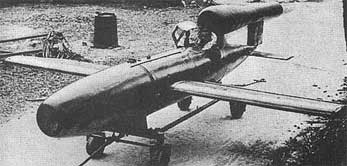 Intended for use against shipping or heavily-defended ground targets,
the piloted Fi 103 missile was developed under the code-name Reichenberg,
and its progenitors were primarily Flugkapitdn Hanna Reitsch,
the internationally-famous German woman pilot, and SS-Hauptsturmfdhrer
Otto Skorzeny. Previously, Flugkapitan Reitsch and a certain Hauptmann
Heinrich Lange had promoted a scheme for the recruiting of a cadre
of pilots willing to sacrifice their lives if necessary by crashing
their aircraft on to important targets. Although this scheme met
with little favorable response from other than a few fanatics,
it was pursued in modified form on a limited scale.
Intended for use against shipping or heavily-defended ground targets,
the piloted Fi 103 missile was developed under the code-name Reichenberg,
and its progenitors were primarily Flugkapitdn Hanna Reitsch,
the internationally-famous German woman pilot, and SS-Hauptsturmfdhrer
Otto Skorzeny. Previously, Flugkapitan Reitsch and a certain Hauptmann
Heinrich Lange had promoted a scheme for the recruiting of a cadre
of pilots willing to sacrifice their lives if necessary by crashing
their aircraft on to important targets. Although this scheme met
with little favorable response from other than a few fanatics,
it was pursued in modified form on a limited scale.
Initial piloted trials were conducted at Lärz in September 1944, the aircraft without power plant being launched from beneath the port wing of an He 111 bomber but crashing when the pilot lost control after inadvertently jettisoning his cockpit canopy. The second flight test on the following day also terminated in the loss of the aircraft.
Four piloted models of the Fi 103 were evolved under the Reichenberg
program, three of these being training variants. These were the
Reichenberg I single-seater with landing skid and flaps; the Reichenberg
II with a  second
cockpit in the position normally occupied by the warhead in the
operational version, and the Reichenberg III single-seater with
a similar arrangement of landing skid and flaps but with the Argus
As 014 impulse duct fitted and ballast compensating for the weight
of the warhead.
second
cockpit in the position normally occupied by the warhead in the
operational version, and the Reichenberg III single-seater with
a similar arrangement of landing skid and flaps but with the Argus
As 014 impulse duct fitted and ballast compensating for the weight
of the warhead.
The operational model was the Reichenberg IV, and its conversion from the standard Fi 103 missile was the essence of simplicity.
The basic Fi-103 fuselage was divided into six compartments respectively
housing the magnetic compass, the 1,874lb. Amatol warhead, the
fuel tank, two circular compressed air bottles, the autopilot
and height and range setting controls, and the servo mechanisms
controlling the rudder and elevators. The conversion to Reichenberg
IV standards included the insertion of a small cockpit ahead of
the propulsive duct. The instrument panel comprised an arming
switch, a clock, an airspeed indicator, an altimeter, and a turn-and-bank
indicator, a gyrocompass being carried by a floor-mounted bracket
which also provided a mounting for a three-phase inverter and
a small 24-volt wet battery. Flight controls were of the conventional
stick-and rudder bar type, and the pilot was accommodated by a
plywood bucket seat with a padded headrest. The single-piece hood,
which incorporated an armour-glass windscreen, hinged to starboard,
and guidelines were provided for calculating diving angles.
The cockpit occupied the space taken in the pilotless version by the compressed air bottles, and the Reichenberg IV was provided with only one compressed air bottle, this being housed in the aft compartment normally occupied by the missile's autopilot. The entire trailing edge of the wing was occupied by the ailerons.
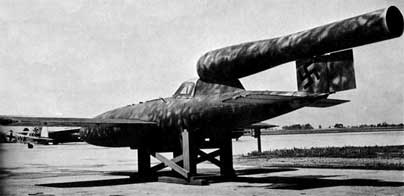 The Reichenberg IV was intended to be carried
to the vicinity of its target beneath an He 111 bomber in a similar
fashion to the pilotless Fi 103s launched
The Reichenberg IV was intended to be carried
to the vicinity of its target beneath an He 111 bomber in a similar
fashion to the pilotless Fi 103s launched
against the British Isles by Kampfgeschwader 53, communication
between pilot and launching aircraft being maintained via a four-channel
connector in the top of the fuselage ahead of the cockpit. In
theory the pilot was intended to jettison the cockpit canopy and
bail out after aiming his aircraft at the target, but it was calculated
that his chance of survival was little better than one in a hundred.
To release the canopy it was necessary to operate a lever on the port side of the cockpit, the canopy having to swing through an angle of 45 degrees before the forward-hinged connection on the starboard side could be detached, and at the estimated target approach speeds of 490-530 m.p.h. it is highly improbable that this method of jettisoning the canopy would have proved practical.
The training of a nucleus of instructors on the Reichenberg I and II was initiated, and although a successful landing called for considerable skill, the unpowered Reichenberg presented no insurmountable problems. In principle, the pilot was to aim the Reichenberg at a target and then bail out. In practice, the weapon lacked an ejection seat, and though provisions were made for escape, getting out of such an aircraft safely as it dived at high speed towards a target was problematic. The volunteer pilots who were to fly the bombs were known as "Selbstopfermaenner (Suicide Men)". Unsurprisingly, many German officers did not like the scheme. In October 1944, a new commander named Werner Baumbach was appointed to KG-200, and he preferred Mistel to Reichenberg. The Germans had little enthusiasm for kamikaze missions.

After Oberstleutnant Werner Baumbach took over as Gesch waderKommodore of KG 200 in October 1944, the entire program was suppressed. By this time some 175 Fi 103 missiles had been adapted for the Reichenberg program but none had been used operationally.
Along with the Reichenberg, another interesting dead-end adaptation of the V-1 was its use as an external fuel tank that could be towed behind an aircraft by a long pipe, with the pipe acting as both tow bar and fuel connection. The scheme was evaluated with an Ar-234 jet bomber, but never got beyond preliminary tests.
Specifications for the Fieseler Fi 103R
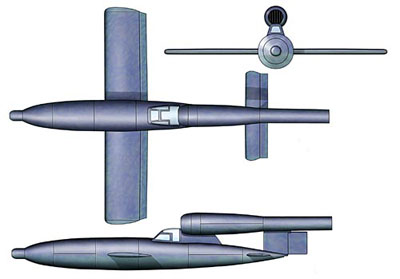 |
Length: 26 ft. 3 in. Armament |
Thought you'd like to see what a quick afternoon build developed. Using the Me 109 cockpit and a bit of adjustment and add-ons, and this is what I came up with. Not one of my better builds, but it shows it can be done! The trouble was the engine is different than the one shown on the info page, the cockpit is different and the rudder has a different shape, and I didn't add the skid on the bottom. If I were to do this again I would change those items and take a bit more time designing the engine and it's attachments and make a smoother fit. Take care! Jim K (1998)
|
 This is the original version designed in 1987 ..or there abouts. It was more graphic than accurate with German markings everywhere |
The American version of the V-1: JB FLYING BOMB aka Loon
The JB-2 is a U.S. made copy of the famous German V-1
surface-to-surface pilotless flying bomb first used against England
on June 12-13, 1944. The airframe for the JB-2 was built by the
Republic Aviation Corporation and the engine by the Ford Motor
Company from drawings prepared at Wright Field, using dimensions
taken from the remains of several V-1s brought from Germany.
About 1,000 JB-2s were built for the Army and Navy. Production delivery began in January 1945, but it was cancelled on VJ Day. The first one to be test flown in the U.S. was launched at Eglin Field, Fla., in October 1944. Just before the end of the war, JB-2s were placed aboard an aircraft carrier en route to the Pacific for possible use in the proposed invasion of the Japanese home islands. Although the JB-2 was never used in combat, it provided valuable data for the design and construction of more advanced weapons.
SPECIFICATIONS JB-2
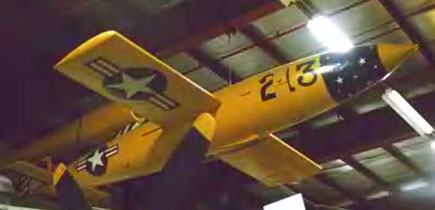 The JB-2 on display was obtained from the Continental Motors Corporation, Muskegan, Mich. in December 1956. |
Span: 17 ft. 8 in. Length: 27 ft. 1 in. Height: 4 ft. 8 in. Weight: 5,023 lbs. loaded Armament: 2,100 lb. high-explosive warhead Engine: Ford PJ-31-F-1 of 900 lbs. thrust (copy of German Argus-Schmidt pulse-jet) Operating speed: 375-400 mph Launching speed: 220 mph Range: 150 miles Operating Altitude: 2,000 to 4,000 ft. |
USAAF JB-2 / JB-1 and Navy KGW-1"Loon"
Despite the V-1's limitations, the US military was very interested
in it. In comparison to the bumbling American efforts in radio-controlled
flying bombs such as the BQ weapons the German V-1 looked pretty good, and in July 1944 captured
V-1 components were shipped to Wright-Patterson Field in Ohio
for evaluation. Within three weeks, the USAAF and American industry
had built their own V-1, which was designated the "Jet Bomb
2 (JB-2)" and more informally known as the "Thunderbug".
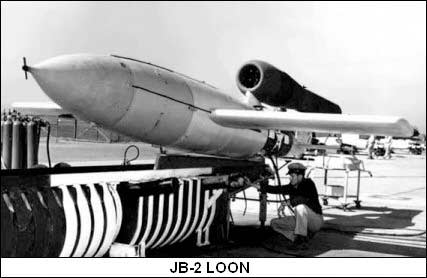 In August, the USAAF placed an order for 1,000 JB-2s with improved
guidance systems: Ford built the pulse jet engine, designated "PJ-31";
Republic built the airframe, though that job would later be subcontracted
to Willys-Overland; and other manufacturers built the control
systems, launch rockets, launch frames, and remaining components.
First successful launch of a JB-2 was on 5 June 1945.
In August, the USAAF placed an order for 1,000 JB-2s with improved
guidance systems: Ford built the pulse jet engine, designated "PJ-31";
Republic built the airframe, though that job would later be subcontracted
to Willys-Overland; and other manufacturers built the control
systems, launch rockets, launch frames, and remaining components.
First successful launch of a JB-2 was on 5 June 1945.
The JB-2s were launched off a rail with a solid rocket booster, in contrast to the somewhat complicated steam catapult system used by the Germans. Two versions of JB-2s were built, one with a gyroscopic guidance system like that used with the V-1, and the other with a radio-radar guidance system.
The USAAF also experimented with air-launching the JB-2. Most of the launches were from a B-17 bomber, though some were performed from B-24s and B-29s, but the USAAF decided it wasn't a good idea in any case. The Air Force was so enthusiastic with the results that they increased the order for JB-2s to 75,000 in January 1945. However, the end of the war in August dampened enthusiasm for the weapon, and the program was terminated in September of that year after over a thousand had been built.
The US Navy experimented with their own V-1 variant, the "KUW-1 (later LTV-N-2) Loon". After initial ground launch tests in 1946, a submarine, the USS CUSK was modified to launch the flying bombs. In February 1947, the CUSK successfully launched a Loon. The flying bomb was stored in a watertight hanger on the deck of the submarine, and assembled and launched by solid rocket boosters while the submarine was on the surface. It was tracked by radar and controlled by radio.
Another submarine, the USS CARBONERO, was used in the tests as a tracking and control platform. In 1948, a surface vessel, the USS NORTON SOUND, was modified for Loon launches, and performed four launches in 1949 and 1950. It doesn't appear that the Navy was ever serious about fielding the Loon but saw it as a useful test vehicle for improved naval cruise missiles.
The Soviets also built copies and derivatives of the V-1 and the
French operated a target drone based on the V-1 and designated
the "Arsenal 5.501" well into the 1950s, though it differed
from the original design in having twin tail fins and radio control.
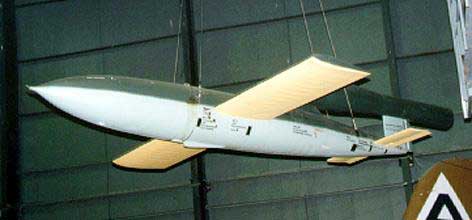 In the summer of 1944, about 2,500 pounds of salvaged German V-1
parts were shipped from England to the United States for analysis.
The U.S. Army Air Force planned to copy the pilotless flying bomb
design and use the weapon against Germany, so engineers at Wright-Patterson
Field studied the V-1 components carefully.
In the summer of 1944, about 2,500 pounds of salvaged German V-1
parts were shipped from England to the United States for analysis.
The U.S. Army Air Force planned to copy the pilotless flying bomb
design and use the weapon against Germany, so engineers at Wright-Patterson
Field studied the V-1 components carefully.
Within three weeks the plans were copied and the first American-built V-1 was finished, designated the JB-2. However, USAAF officials noted the flying bomb design's inherent inaccuracy over long ranges and realized the device was really only effective as a "weapon of terror" unless the long-range accuracy was significantly improved. Despite this realization, the government ordered the JB-2 into production for use in the European Theatre, with thousands of the flying bombs to be built.
Republic Aircraft Corporation was given the contract for the overall airframe (later subcontracted to Willys-Overland), Ford Motor Company was to produce the pulse jet engine, Jack and Heintz the control devices, and Alloy Products the pressurized containers for the fuel and compressed air. Northrop was contracted to produce the launch sleds and Monsanto the launch rockets. USAAF flight testing was conducted at Eglin Field in Florida and Wendover Field in Utah to perfect the guidance system for the JB-2.
JB-2 flight testing at Wendover Field, Utah The JB-2 (and the U.S. Navy variant of the JB-2, the "Loon") differed very little from the original German V-1 design. Only the method of launch and the guidance system were changed appreciably by American designers.
The USAAF also experimented briefly with air launch of the device from Boeing B-17s, but concentrated on ground launch techniques after a time. Early test flights failed, but finally on 5 June 1945 the USAAF JB-2 flew successfully for the first time. However, World War II was fast drawing to a close and the need for the JB-2 weapon system was reduced. When production was finally terminated in September 1945 only 1,385 JB-2s had been delivered to the War Department.
This JB-2 flying bomb is an American-built duplicate of the German V-1. It was recovered from the test range at Wendover Field, where captured German V-1s and their American counterparts underwent evaluation and flight testing during the late 1940s. Army JB-2s earned the nickname "Wendover Willie" during testing in the Utah desert, and each example usually made several flights before being either retired or destroyed in crashes or explosions. This example was restored by the 649th Combat Logistics Support Squadron at Hill Aerospace Museum in 1995.
Japanese Versions:
In 1944 an Argus pulse jet engine was shipped to Japan by German
submarine. The Aeronautical Institute of Tokyo Imperial University
and the Kawanishi Aircraft Company conducted a joint study of the
feasibility of mounting a similar engine on a piloted plane. The
resulting design was based on the Fieseler Fi-103 "Reichenberg"
(Fi103R ) manned V-1, and was the Yokosuka Ohka.
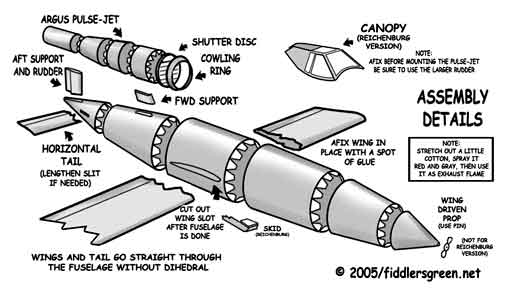
Specifications for the V-1
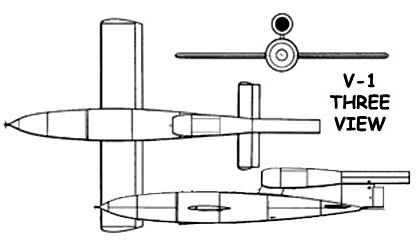 |
Weight: 4,750 lb Length: 27 feet 3.75 inches Width: 17 feet 6 inches Height: 4 feet 8 inches Warhead: Amatol-39 Warhead Weight: 1,870 lb Engine: Argus As 109-014 pulse jet engine Operational Range: 150 miles Speed: 400 mph flying between 2,000 to 3,000 ft |
 |
|||
| A: A simple bead sight supposedly aided target lineup, and dive angles marked on the side window provided the pilot last minute reading before he left his mount to its fate. | B: The Reichenberg IV had only basic instrumentation and could supposedly be flown after minimal training. The cockpit had only four instruments. | C: The nose of the Fi 103R-IV was packed with 1764Ib of explosives. | D: Having reached his target, the pilot was supposed to aim accurately and then bailout, somehow avoiding the sucking intake of the pulse jet behind him. There was no landing gear. |
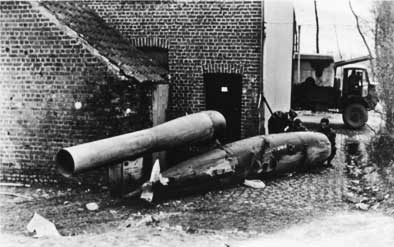 |
Wartime flying bomb found in British capital (German V1 "Doodlebug") |



